Marketing Essentials for Travel And Tourism - TUI Assignment
VerifiedAdded on 2021/02/19
|17
|3689
|16
AI Summary
Contribute Materials
Your contribution can guide someone’s learning journey. Share your
documents today.
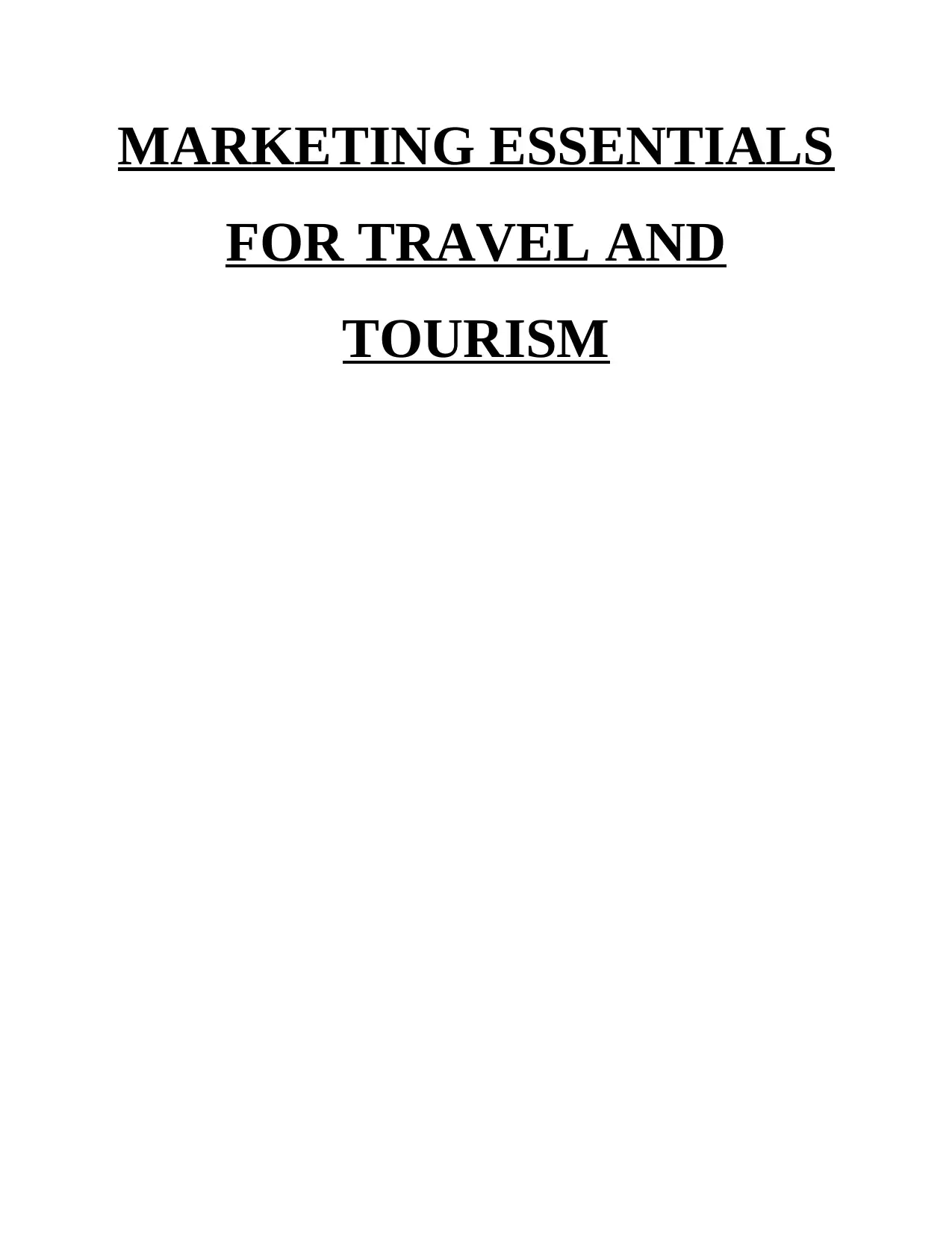
MARKETING ESSENTIALS
FOR TRAVEL AND
TOURISM
FOR TRAVEL AND
TOURISM
Secure Best Marks with AI Grader
Need help grading? Try our AI Grader for instant feedback on your assignments.
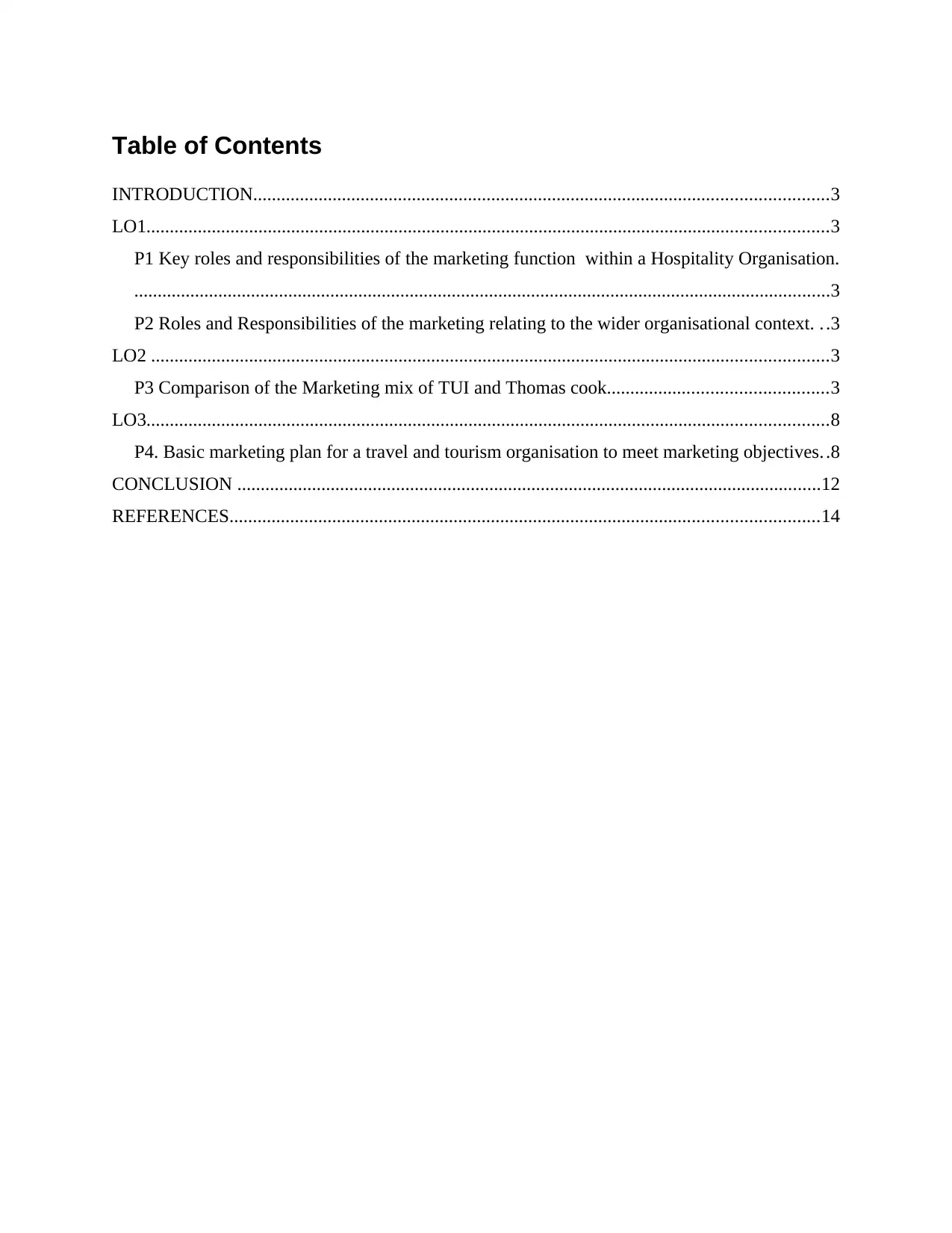
Table of Contents
INTRODUCTION...........................................................................................................................3
LO1..................................................................................................................................................3
P1 Key roles and responsibilities of the marketing function within a Hospitality Organisation.
.....................................................................................................................................................3
P2 Roles and Responsibilities of the marketing relating to the wider organisational context. . .3
LO2 .................................................................................................................................................3
P3 Comparison of the Marketing mix of TUI and Thomas cook...............................................3
LO3..................................................................................................................................................8
P4. Basic marketing plan for a travel and tourism organisation to meet marketing objectives. .8
CONCLUSION .............................................................................................................................12
REFERENCES..............................................................................................................................14
INTRODUCTION...........................................................................................................................3
LO1..................................................................................................................................................3
P1 Key roles and responsibilities of the marketing function within a Hospitality Organisation.
.....................................................................................................................................................3
P2 Roles and Responsibilities of the marketing relating to the wider organisational context. . .3
LO2 .................................................................................................................................................3
P3 Comparison of the Marketing mix of TUI and Thomas cook...............................................3
LO3..................................................................................................................................................8
P4. Basic marketing plan for a travel and tourism organisation to meet marketing objectives. .8
CONCLUSION .............................................................................................................................12
REFERENCES..............................................................................................................................14
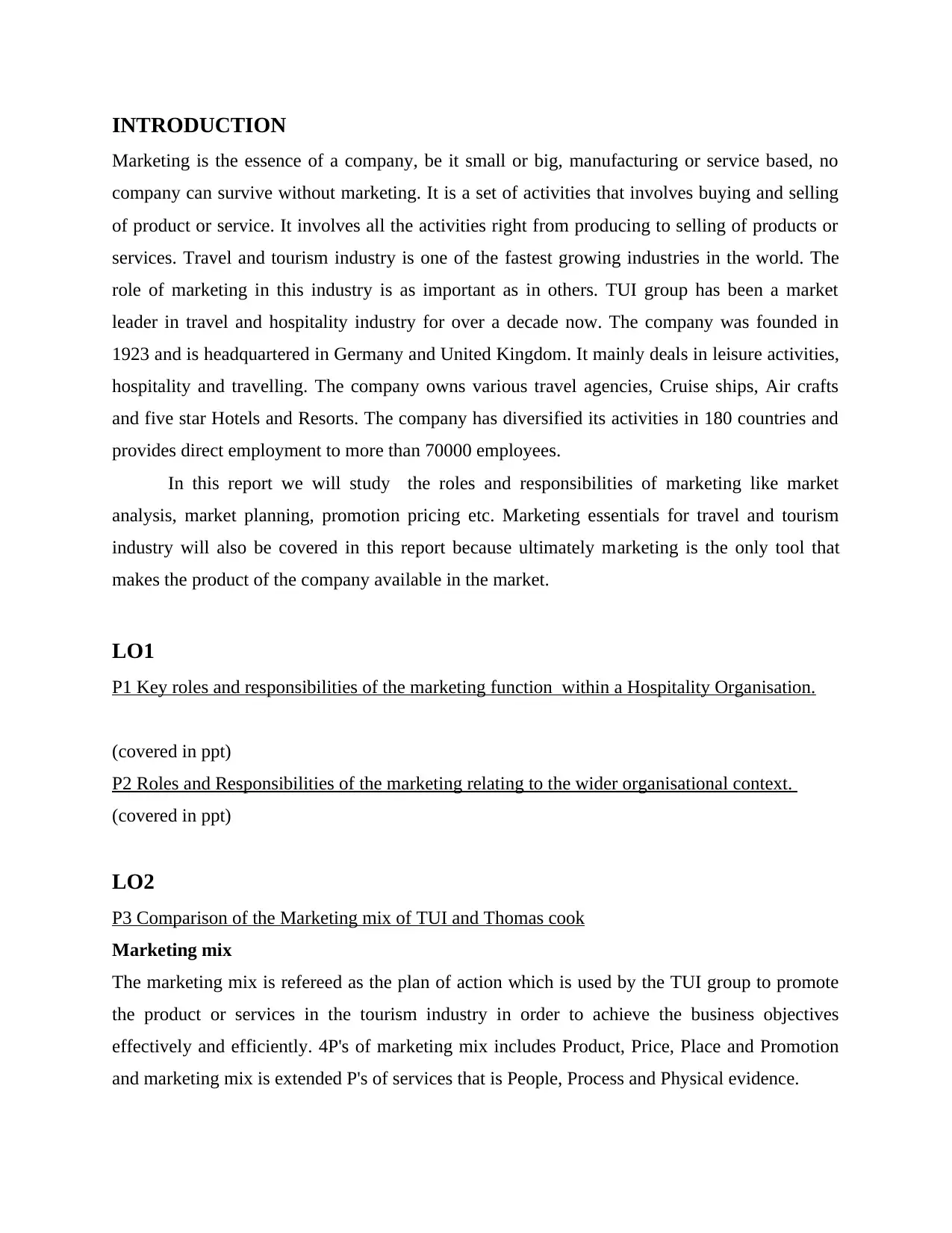
INTRODUCTION
Marketing is the essence of a company, be it small or big, manufacturing or service based, no
company can survive without marketing. It is a set of activities that involves buying and selling
of product or service. It involves all the activities right from producing to selling of products or
services. Travel and tourism industry is one of the fastest growing industries in the world. The
role of marketing in this industry is as important as in others. TUI group has been a market
leader in travel and hospitality industry for over a decade now. The company was founded in
1923 and is headquartered in Germany and United Kingdom. It mainly deals in leisure activities,
hospitality and travelling. The company owns various travel agencies, Cruise ships, Air crafts
and five star Hotels and Resorts. The company has diversified its activities in 180 countries and
provides direct employment to more than 70000 employees.
In this report we will study the roles and responsibilities of marketing like market
analysis, market planning, promotion pricing etc. Marketing essentials for travel and tourism
industry will also be covered in this report because ultimately marketing is the only tool that
makes the product of the company available in the market.
LO1
P1 Key roles and responsibilities of the marketing function within a Hospitality Organisation.
(covered in ppt)
P2 Roles and Responsibilities of the marketing relating to the wider organisational context.
(covered in ppt)
LO2
P3 Comparison of the Marketing mix of TUI and Thomas cook
Marketing mix
The marketing mix is refereed as the plan of action which is used by the TUI group to promote
the product or services in the tourism industry in order to achieve the business objectives
effectively and efficiently. 4P's of marketing mix includes Product, Price, Place and Promotion
and marketing mix is extended P's of services that is People, Process and Physical evidence.
Marketing is the essence of a company, be it small or big, manufacturing or service based, no
company can survive without marketing. It is a set of activities that involves buying and selling
of product or service. It involves all the activities right from producing to selling of products or
services. Travel and tourism industry is one of the fastest growing industries in the world. The
role of marketing in this industry is as important as in others. TUI group has been a market
leader in travel and hospitality industry for over a decade now. The company was founded in
1923 and is headquartered in Germany and United Kingdom. It mainly deals in leisure activities,
hospitality and travelling. The company owns various travel agencies, Cruise ships, Air crafts
and five star Hotels and Resorts. The company has diversified its activities in 180 countries and
provides direct employment to more than 70000 employees.
In this report we will study the roles and responsibilities of marketing like market
analysis, market planning, promotion pricing etc. Marketing essentials for travel and tourism
industry will also be covered in this report because ultimately marketing is the only tool that
makes the product of the company available in the market.
LO1
P1 Key roles and responsibilities of the marketing function within a Hospitality Organisation.
(covered in ppt)
P2 Roles and Responsibilities of the marketing relating to the wider organisational context.
(covered in ppt)
LO2
P3 Comparison of the Marketing mix of TUI and Thomas cook
Marketing mix
The marketing mix is refereed as the plan of action which is used by the TUI group to promote
the product or services in the tourism industry in order to achieve the business objectives
effectively and efficiently. 4P's of marketing mix includes Product, Price, Place and Promotion
and marketing mix is extended P's of services that is People, Process and Physical evidence.
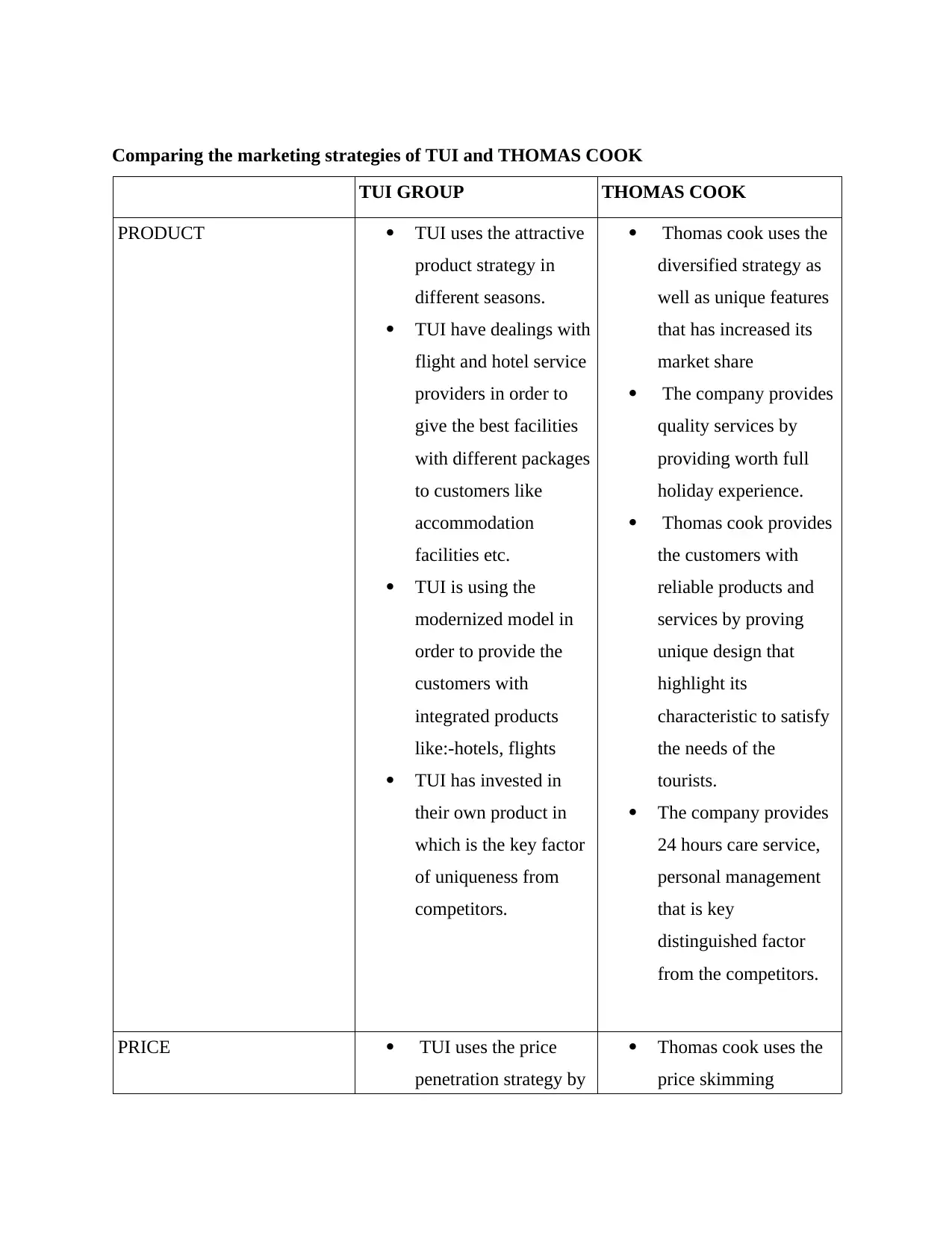
Comparing the marketing strategies of TUI and THOMAS COOK
TUI GROUP THOMAS COOK
PRODUCT TUI uses the attractive
product strategy in
different seasons.
TUI have dealings with
flight and hotel service
providers in order to
give the best facilities
with different packages
to customers like
accommodation
facilities etc.
TUI is using the
modernized model in
order to provide the
customers with
integrated products
like:-hotels, flights
TUI has invested in
their own product in
which is the key factor
of uniqueness from
competitors.
Thomas cook uses the
diversified strategy as
well as unique features
that has increased its
market share
The company provides
quality services by
providing worth full
holiday experience.
Thomas cook provides
the customers with
reliable products and
services by proving
unique design that
highlight its
characteristic to satisfy
the needs of the
tourists.
The company provides
24 hours care service,
personal management
that is key
distinguished factor
from the competitors.
PRICE TUI uses the price
penetration strategy by
Thomas cook uses the
price skimming
TUI GROUP THOMAS COOK
PRODUCT TUI uses the attractive
product strategy in
different seasons.
TUI have dealings with
flight and hotel service
providers in order to
give the best facilities
with different packages
to customers like
accommodation
facilities etc.
TUI is using the
modernized model in
order to provide the
customers with
integrated products
like:-hotels, flights
TUI has invested in
their own product in
which is the key factor
of uniqueness from
competitors.
Thomas cook uses the
diversified strategy as
well as unique features
that has increased its
market share
The company provides
quality services by
providing worth full
holiday experience.
Thomas cook provides
the customers with
reliable products and
services by proving
unique design that
highlight its
characteristic to satisfy
the needs of the
tourists.
The company provides
24 hours care service,
personal management
that is key
distinguished factor
from the competitors.
PRICE TUI uses the price
penetration strategy by
Thomas cook uses the
price skimming
Secure Best Marks with AI Grader
Need help grading? Try our AI Grader for instant feedback on your assignments.
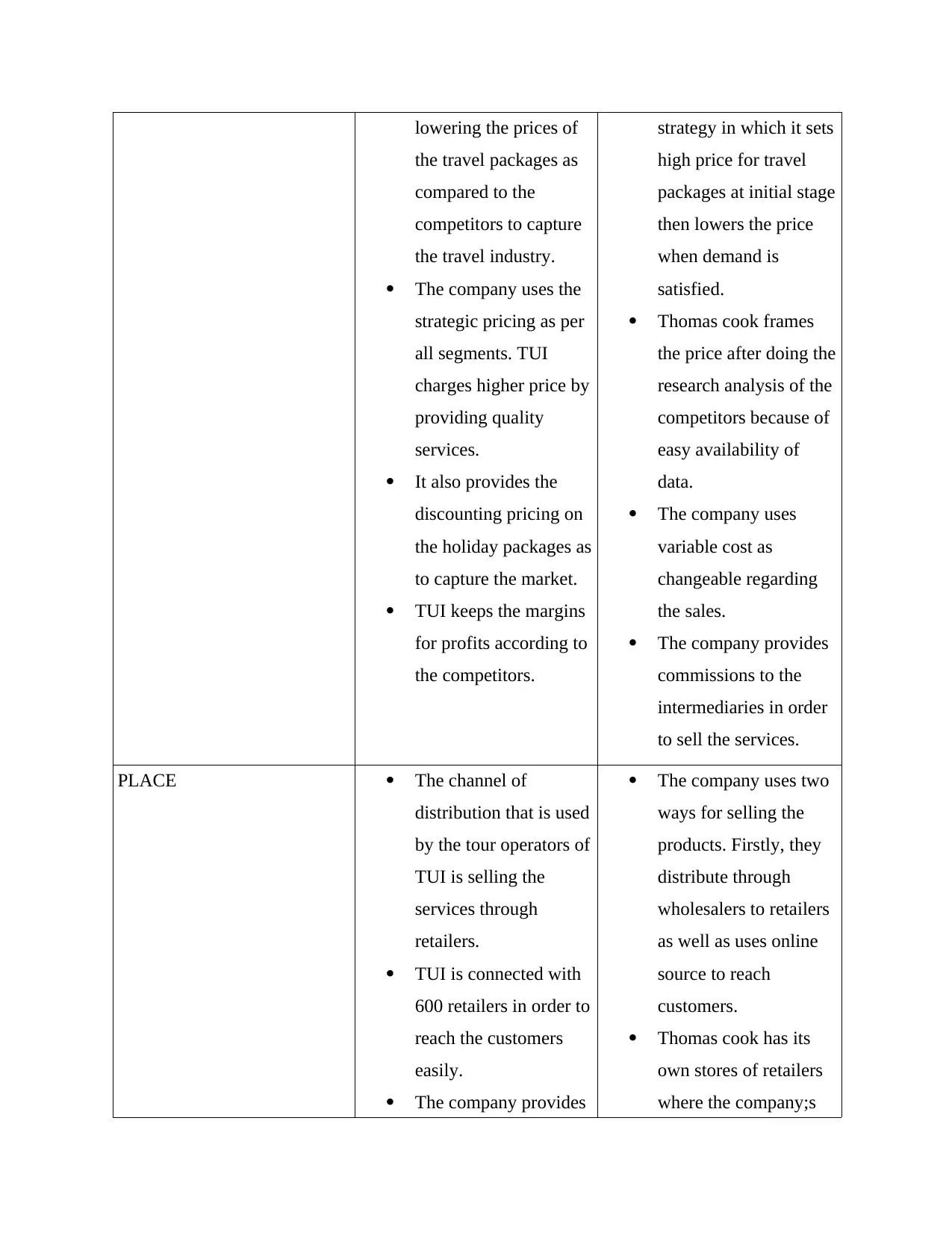
lowering the prices of
the travel packages as
compared to the
competitors to capture
the travel industry.
The company uses the
strategic pricing as per
all segments. TUI
charges higher price by
providing quality
services.
It also provides the
discounting pricing on
the holiday packages as
to capture the market.
TUI keeps the margins
for profits according to
the competitors.
strategy in which it sets
high price for travel
packages at initial stage
then lowers the price
when demand is
satisfied.
Thomas cook frames
the price after doing the
research analysis of the
competitors because of
easy availability of
data.
The company uses
variable cost as
changeable regarding
the sales.
The company provides
commissions to the
intermediaries in order
to sell the services.
PLACE The channel of
distribution that is used
by the tour operators of
TUI is selling the
services through
retailers.
TUI is connected with
600 retailers in order to
reach the customers
easily.
The company provides
The company uses two
ways for selling the
products. Firstly, they
distribute through
wholesalers to retailers
as well as uses online
source to reach
customers.
Thomas cook has its
own stores of retailers
where the company;s
the travel packages as
compared to the
competitors to capture
the travel industry.
The company uses the
strategic pricing as per
all segments. TUI
charges higher price by
providing quality
services.
It also provides the
discounting pricing on
the holiday packages as
to capture the market.
TUI keeps the margins
for profits according to
the competitors.
strategy in which it sets
high price for travel
packages at initial stage
then lowers the price
when demand is
satisfied.
Thomas cook frames
the price after doing the
research analysis of the
competitors because of
easy availability of
data.
The company uses
variable cost as
changeable regarding
the sales.
The company provides
commissions to the
intermediaries in order
to sell the services.
PLACE The channel of
distribution that is used
by the tour operators of
TUI is selling the
services through
retailers.
TUI is connected with
600 retailers in order to
reach the customers
easily.
The company provides
The company uses two
ways for selling the
products. Firstly, they
distribute through
wholesalers to retailers
as well as uses online
source to reach
customers.
Thomas cook has its
own stores of retailers
where the company;s
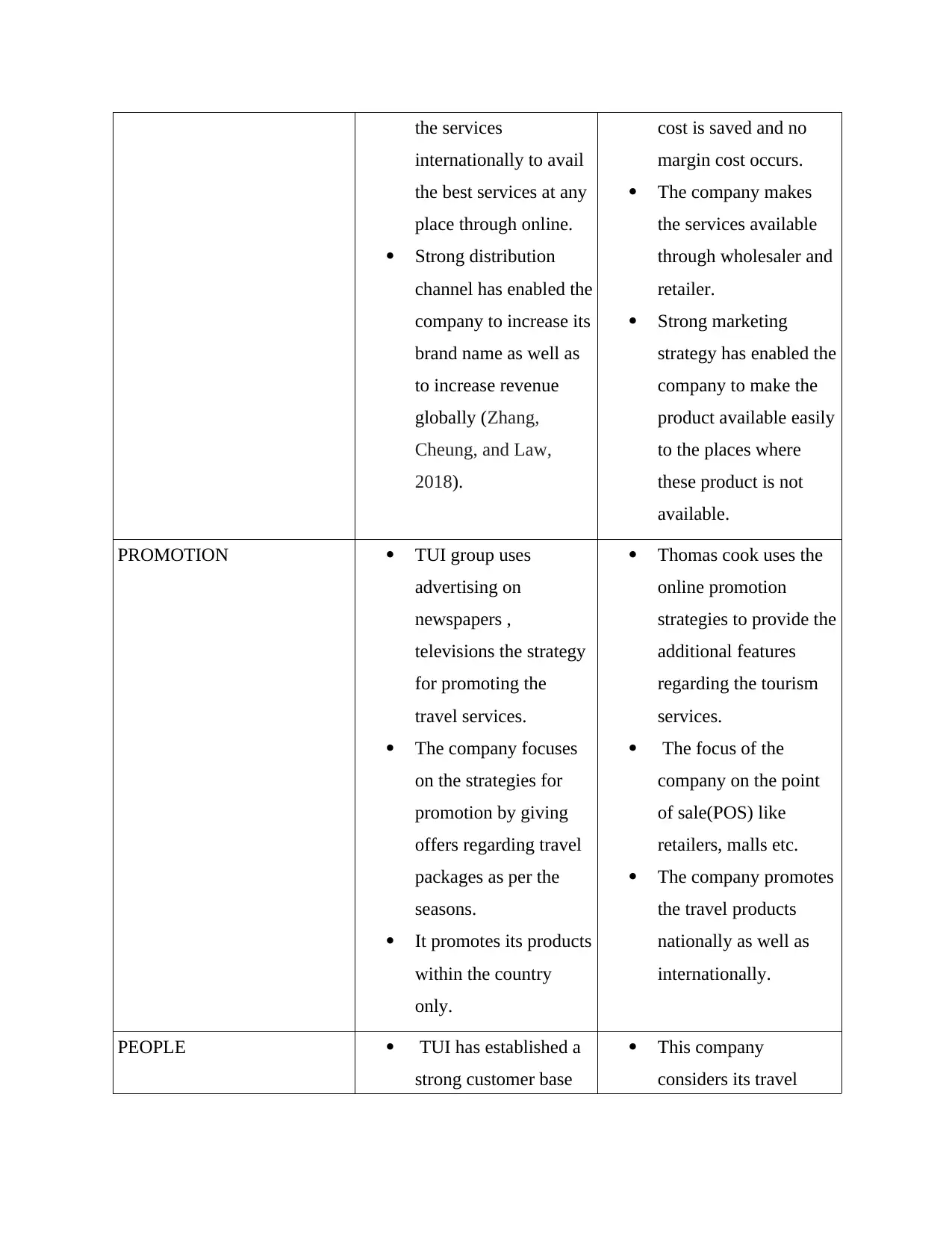
the services
internationally to avail
the best services at any
place through online.
Strong distribution
channel has enabled the
company to increase its
brand name as well as
to increase revenue
globally (Zhang,
Cheung, and Law,
2018).
cost is saved and no
margin cost occurs.
The company makes
the services available
through wholesaler and
retailer.
Strong marketing
strategy has enabled the
company to make the
product available easily
to the places where
these product is not
available.
PROMOTION TUI group uses
advertising on
newspapers ,
televisions the strategy
for promoting the
travel services.
The company focuses
on the strategies for
promotion by giving
offers regarding travel
packages as per the
seasons.
It promotes its products
within the country
only.
Thomas cook uses the
online promotion
strategies to provide the
additional features
regarding the tourism
services.
The focus of the
company on the point
of sale(POS) like
retailers, malls etc.
The company promotes
the travel products
nationally as well as
internationally.
PEOPLE TUI has established a
strong customer base
This company
considers its travel
internationally to avail
the best services at any
place through online.
Strong distribution
channel has enabled the
company to increase its
brand name as well as
to increase revenue
globally (Zhang,
Cheung, and Law,
2018).
cost is saved and no
margin cost occurs.
The company makes
the services available
through wholesaler and
retailer.
Strong marketing
strategy has enabled the
company to make the
product available easily
to the places where
these product is not
available.
PROMOTION TUI group uses
advertising on
newspapers ,
televisions the strategy
for promoting the
travel services.
The company focuses
on the strategies for
promotion by giving
offers regarding travel
packages as per the
seasons.
It promotes its products
within the country
only.
Thomas cook uses the
online promotion
strategies to provide the
additional features
regarding the tourism
services.
The focus of the
company on the point
of sale(POS) like
retailers, malls etc.
The company promotes
the travel products
nationally as well as
internationally.
PEOPLE TUI has established a
strong customer base
This company
considers its travel
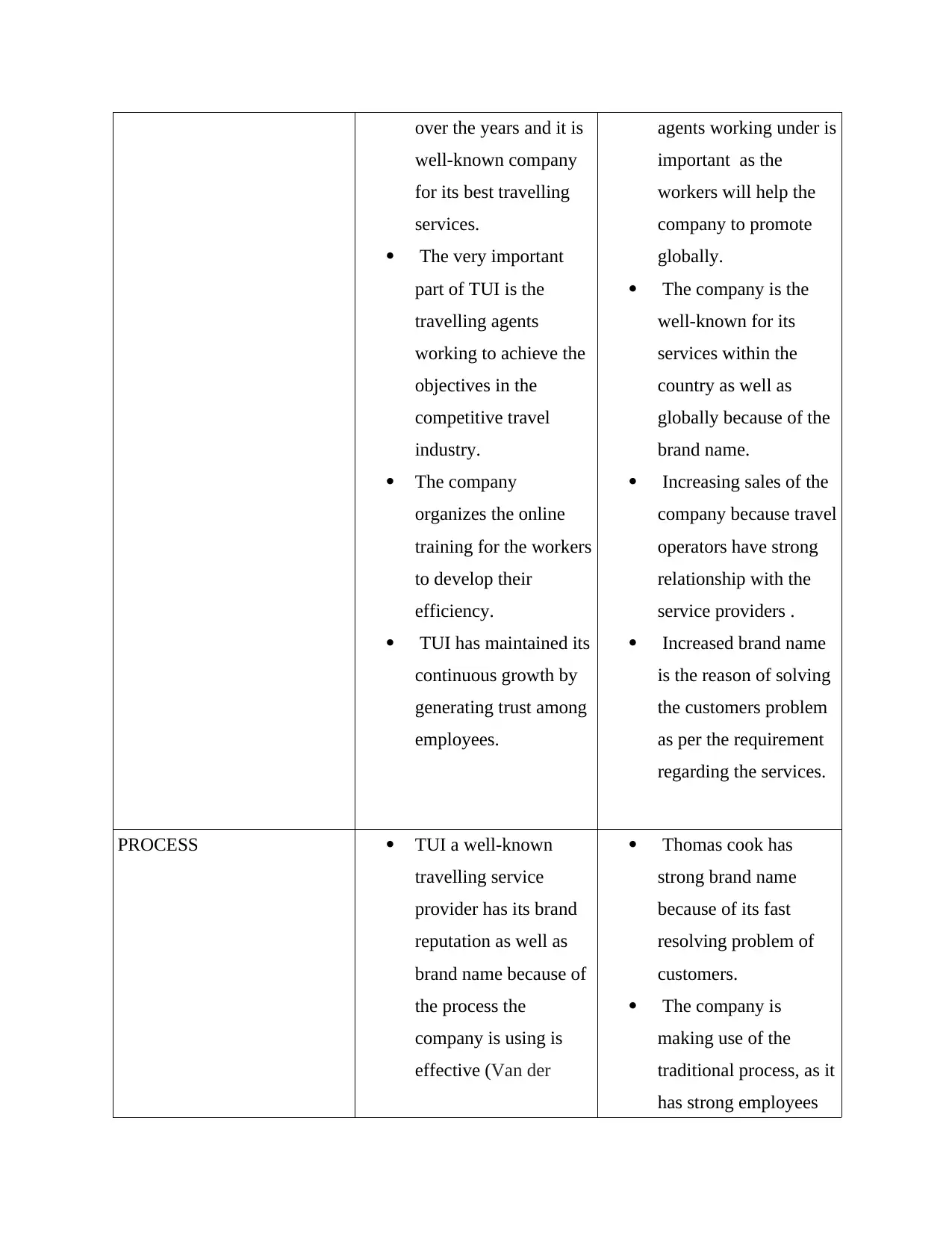
over the years and it is
well-known company
for its best travelling
services.
The very important
part of TUI is the
travelling agents
working to achieve the
objectives in the
competitive travel
industry.
The company
organizes the online
training for the workers
to develop their
efficiency.
TUI has maintained its
continuous growth by
generating trust among
employees.
agents working under is
important as the
workers will help the
company to promote
globally.
The company is the
well-known for its
services within the
country as well as
globally because of the
brand name.
Increasing sales of the
company because travel
operators have strong
relationship with the
service providers .
Increased brand name
is the reason of solving
the customers problem
as per the requirement
regarding the services.
PROCESS TUI a well-known
travelling service
provider has its brand
reputation as well as
brand name because of
the process the
company is using is
effective (Van der
Thomas cook has
strong brand name
because of its fast
resolving problem of
customers.
The company is
making use of the
traditional process, as it
has strong employees
well-known company
for its best travelling
services.
The very important
part of TUI is the
travelling agents
working to achieve the
objectives in the
competitive travel
industry.
The company
organizes the online
training for the workers
to develop their
efficiency.
TUI has maintained its
continuous growth by
generating trust among
employees.
agents working under is
important as the
workers will help the
company to promote
globally.
The company is the
well-known for its
services within the
country as well as
globally because of the
brand name.
Increasing sales of the
company because travel
operators have strong
relationship with the
service providers .
Increased brand name
is the reason of solving
the customers problem
as per the requirement
regarding the services.
PROCESS TUI a well-known
travelling service
provider has its brand
reputation as well as
brand name because of
the process the
company is using is
effective (Van der
Thomas cook has
strong brand name
because of its fast
resolving problem of
customers.
The company is
making use of the
traditional process, as it
has strong employees
Paraphrase This Document
Need a fresh take? Get an instant paraphrase of this document with our AI Paraphraser
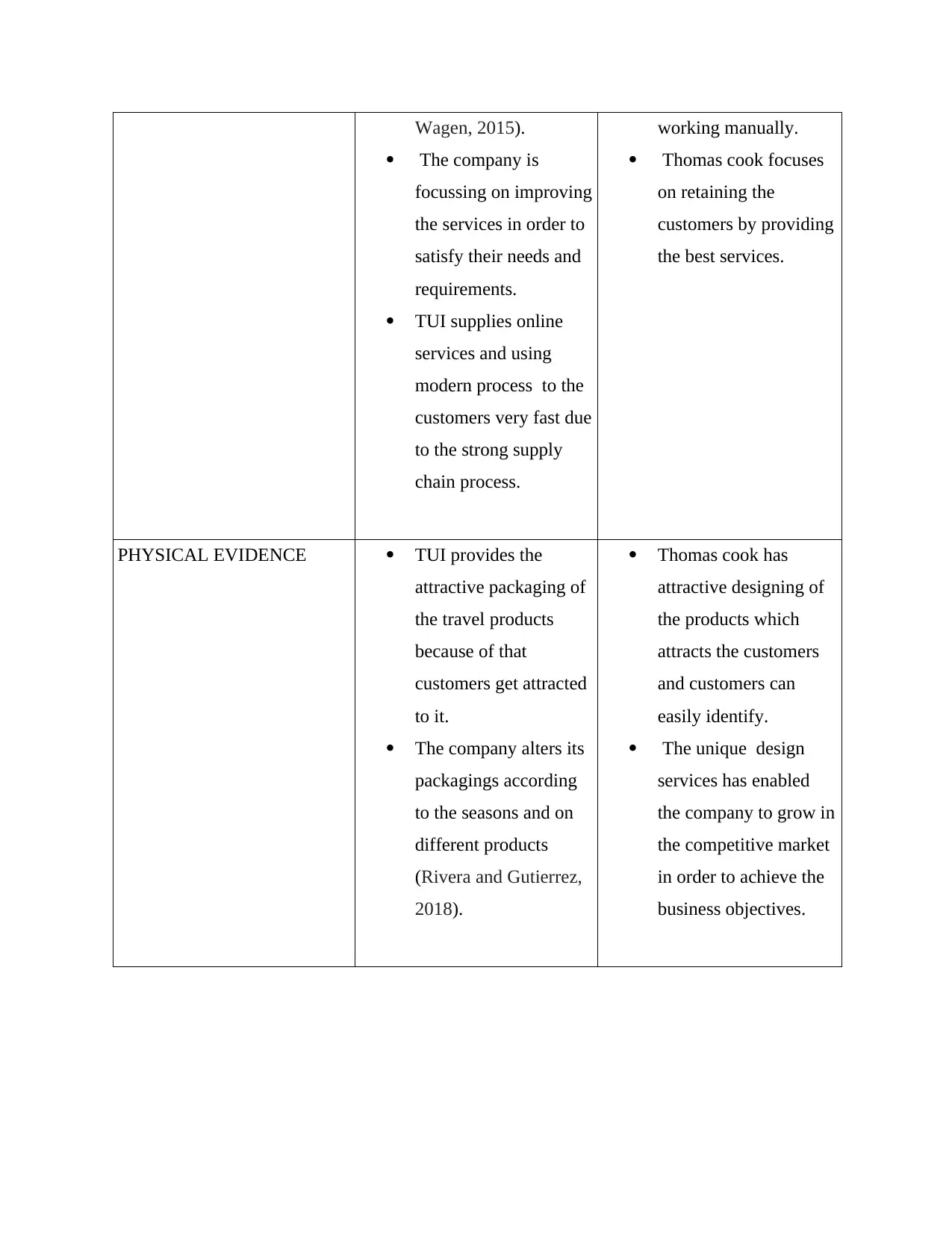
Wagen, 2015).
The company is
focussing on improving
the services in order to
satisfy their needs and
requirements.
TUI supplies online
services and using
modern process to the
customers very fast due
to the strong supply
chain process.
working manually.
Thomas cook focuses
on retaining the
customers by providing
the best services.
PHYSICAL EVIDENCE TUI provides the
attractive packaging of
the travel products
because of that
customers get attracted
to it.
The company alters its
packagings according
to the seasons and on
different products
(Rivera and Gutierrez,
2018).
Thomas cook has
attractive designing of
the products which
attracts the customers
and customers can
easily identify.
The unique design
services has enabled
the company to grow in
the competitive market
in order to achieve the
business objectives.
The company is
focussing on improving
the services in order to
satisfy their needs and
requirements.
TUI supplies online
services and using
modern process to the
customers very fast due
to the strong supply
chain process.
working manually.
Thomas cook focuses
on retaining the
customers by providing
the best services.
PHYSICAL EVIDENCE TUI provides the
attractive packaging of
the travel products
because of that
customers get attracted
to it.
The company alters its
packagings according
to the seasons and on
different products
(Rivera and Gutierrez,
2018).
Thomas cook has
attractive designing of
the products which
attracts the customers
and customers can
easily identify.
The unique design
services has enabled
the company to grow in
the competitive market
in order to achieve the
business objectives.
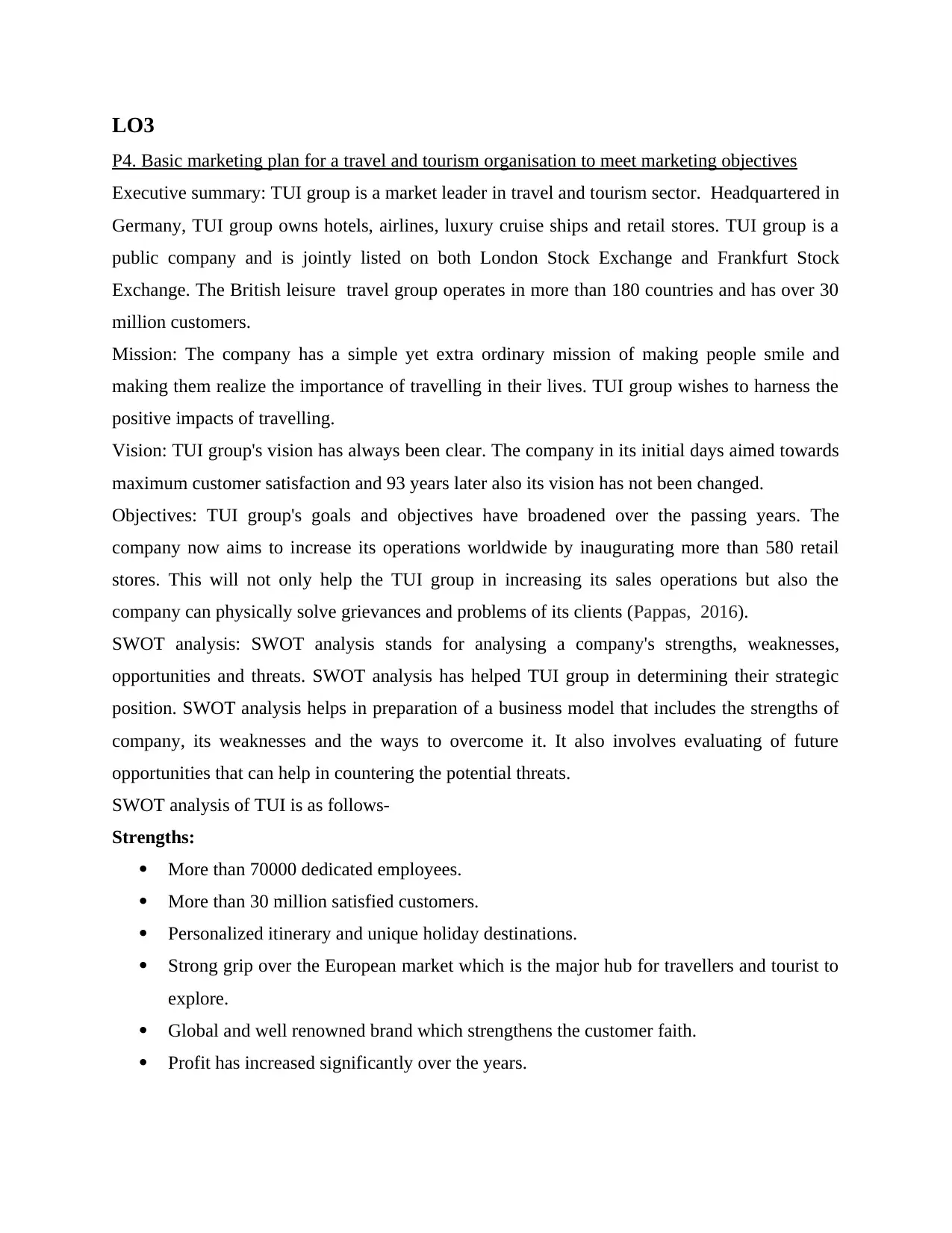
LO3
P4. Basic marketing plan for a travel and tourism organisation to meet marketing objectives
Executive summary: TUI group is a market leader in travel and tourism sector. Headquartered in
Germany, TUI group owns hotels, airlines, luxury cruise ships and retail stores. TUI group is a
public company and is jointly listed on both London Stock Exchange and Frankfurt Stock
Exchange. The British leisure travel group operates in more than 180 countries and has over 30
million customers.
Mission: The company has a simple yet extra ordinary mission of making people smile and
making them realize the importance of travelling in their lives. TUI group wishes to harness the
positive impacts of travelling.
Vision: TUI group's vision has always been clear. The company in its initial days aimed towards
maximum customer satisfaction and 93 years later also its vision has not been changed.
Objectives: TUI group's goals and objectives have broadened over the passing years. The
company now aims to increase its operations worldwide by inaugurating more than 580 retail
stores. This will not only help the TUI group in increasing its sales operations but also the
company can physically solve grievances and problems of its clients (Pappas, 2016).
SWOT analysis: SWOT analysis stands for analysing a company's strengths, weaknesses,
opportunities and threats. SWOT analysis has helped TUI group in determining their strategic
position. SWOT analysis helps in preparation of a business model that includes the strengths of
company, its weaknesses and the ways to overcome it. It also involves evaluating of future
opportunities that can help in countering the potential threats.
SWOT analysis of TUI is as follows-
Strengths:
More than 70000 dedicated employees.
More than 30 million satisfied customers.
Personalized itinerary and unique holiday destinations.
Strong grip over the European market which is the major hub for travellers and tourist to
explore.
Global and well renowned brand which strengthens the customer faith.
Profit has increased significantly over the years.
P4. Basic marketing plan for a travel and tourism organisation to meet marketing objectives
Executive summary: TUI group is a market leader in travel and tourism sector. Headquartered in
Germany, TUI group owns hotels, airlines, luxury cruise ships and retail stores. TUI group is a
public company and is jointly listed on both London Stock Exchange and Frankfurt Stock
Exchange. The British leisure travel group operates in more than 180 countries and has over 30
million customers.
Mission: The company has a simple yet extra ordinary mission of making people smile and
making them realize the importance of travelling in their lives. TUI group wishes to harness the
positive impacts of travelling.
Vision: TUI group's vision has always been clear. The company in its initial days aimed towards
maximum customer satisfaction and 93 years later also its vision has not been changed.
Objectives: TUI group's goals and objectives have broadened over the passing years. The
company now aims to increase its operations worldwide by inaugurating more than 580 retail
stores. This will not only help the TUI group in increasing its sales operations but also the
company can physically solve grievances and problems of its clients (Pappas, 2016).
SWOT analysis: SWOT analysis stands for analysing a company's strengths, weaknesses,
opportunities and threats. SWOT analysis has helped TUI group in determining their strategic
position. SWOT analysis helps in preparation of a business model that includes the strengths of
company, its weaknesses and the ways to overcome it. It also involves evaluating of future
opportunities that can help in countering the potential threats.
SWOT analysis of TUI is as follows-
Strengths:
More than 70000 dedicated employees.
More than 30 million satisfied customers.
Personalized itinerary and unique holiday destinations.
Strong grip over the European market which is the major hub for travellers and tourist to
explore.
Global and well renowned brand which strengthens the customer faith.
Profit has increased significantly over the years.
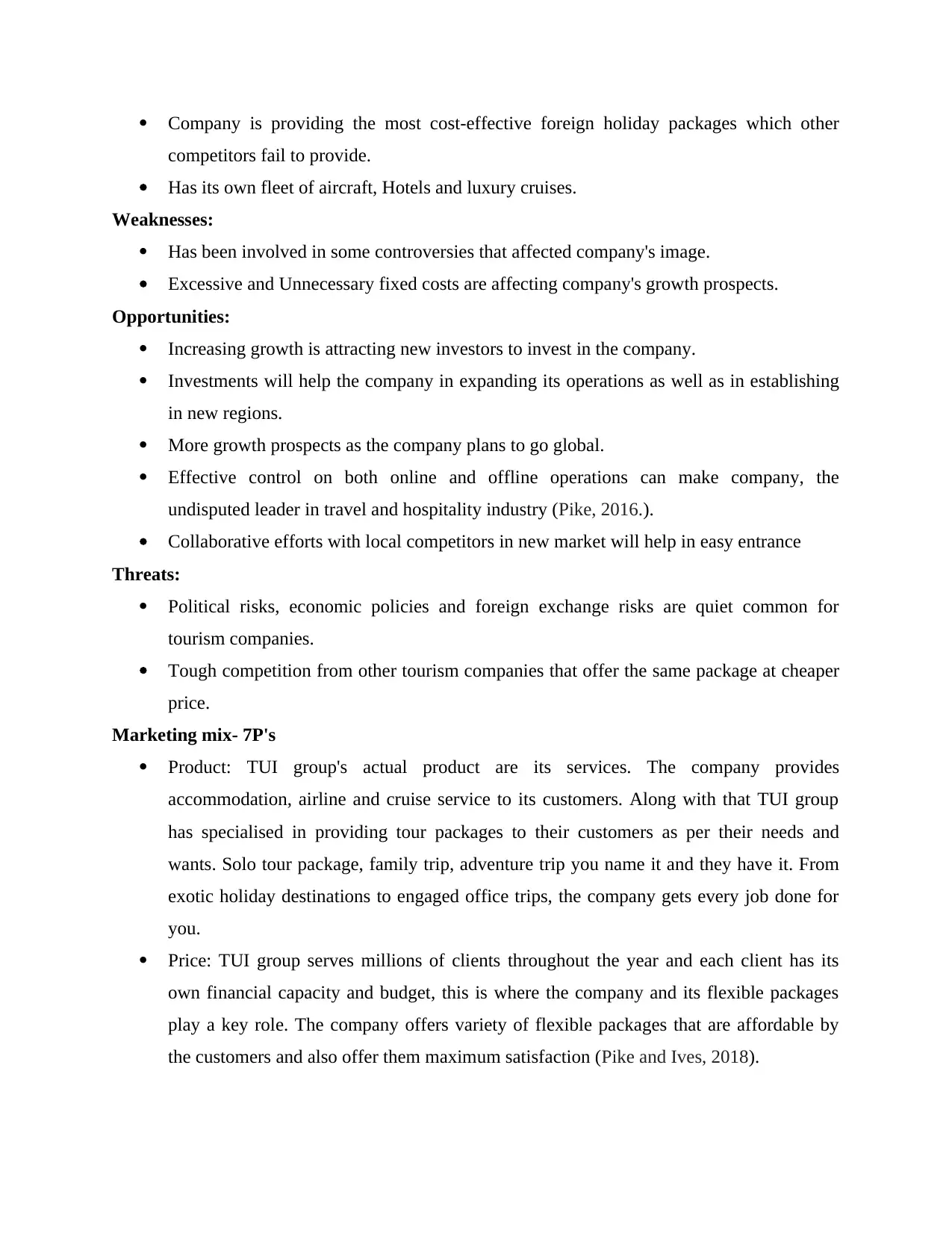
Company is providing the most cost-effective foreign holiday packages which other
competitors fail to provide.
Has its own fleet of aircraft, Hotels and luxury cruises.
Weaknesses:
Has been involved in some controversies that affected company's image.
Excessive and Unnecessary fixed costs are affecting company's growth prospects.
Opportunities:
Increasing growth is attracting new investors to invest in the company.
Investments will help the company in expanding its operations as well as in establishing
in new regions.
More growth prospects as the company plans to go global.
Effective control on both online and offline operations can make company, the
undisputed leader in travel and hospitality industry (Pike, 2016.).
Collaborative efforts with local competitors in new market will help in easy entrance
Threats:
Political risks, economic policies and foreign exchange risks are quiet common for
tourism companies.
Tough competition from other tourism companies that offer the same package at cheaper
price.
Marketing mix- 7P's
Product: TUI group's actual product are its services. The company provides
accommodation, airline and cruise service to its customers. Along with that TUI group
has specialised in providing tour packages to their customers as per their needs and
wants. Solo tour package, family trip, adventure trip you name it and they have it. From
exotic holiday destinations to engaged office trips, the company gets every job done for
you.
Price: TUI group serves millions of clients throughout the year and each client has its
own financial capacity and budget, this is where the company and its flexible packages
play a key role. The company offers variety of flexible packages that are affordable by
the customers and also offer them maximum satisfaction (Pike and Ives, 2018).
competitors fail to provide.
Has its own fleet of aircraft, Hotels and luxury cruises.
Weaknesses:
Has been involved in some controversies that affected company's image.
Excessive and Unnecessary fixed costs are affecting company's growth prospects.
Opportunities:
Increasing growth is attracting new investors to invest in the company.
Investments will help the company in expanding its operations as well as in establishing
in new regions.
More growth prospects as the company plans to go global.
Effective control on both online and offline operations can make company, the
undisputed leader in travel and hospitality industry (Pike, 2016.).
Collaborative efforts with local competitors in new market will help in easy entrance
Threats:
Political risks, economic policies and foreign exchange risks are quiet common for
tourism companies.
Tough competition from other tourism companies that offer the same package at cheaper
price.
Marketing mix- 7P's
Product: TUI group's actual product are its services. The company provides
accommodation, airline and cruise service to its customers. Along with that TUI group
has specialised in providing tour packages to their customers as per their needs and
wants. Solo tour package, family trip, adventure trip you name it and they have it. From
exotic holiday destinations to engaged office trips, the company gets every job done for
you.
Price: TUI group serves millions of clients throughout the year and each client has its
own financial capacity and budget, this is where the company and its flexible packages
play a key role. The company offers variety of flexible packages that are affordable by
the customers and also offer them maximum satisfaction (Pike and Ives, 2018).
Secure Best Marks with AI Grader
Need help grading? Try our AI Grader for instant feedback on your assignments.
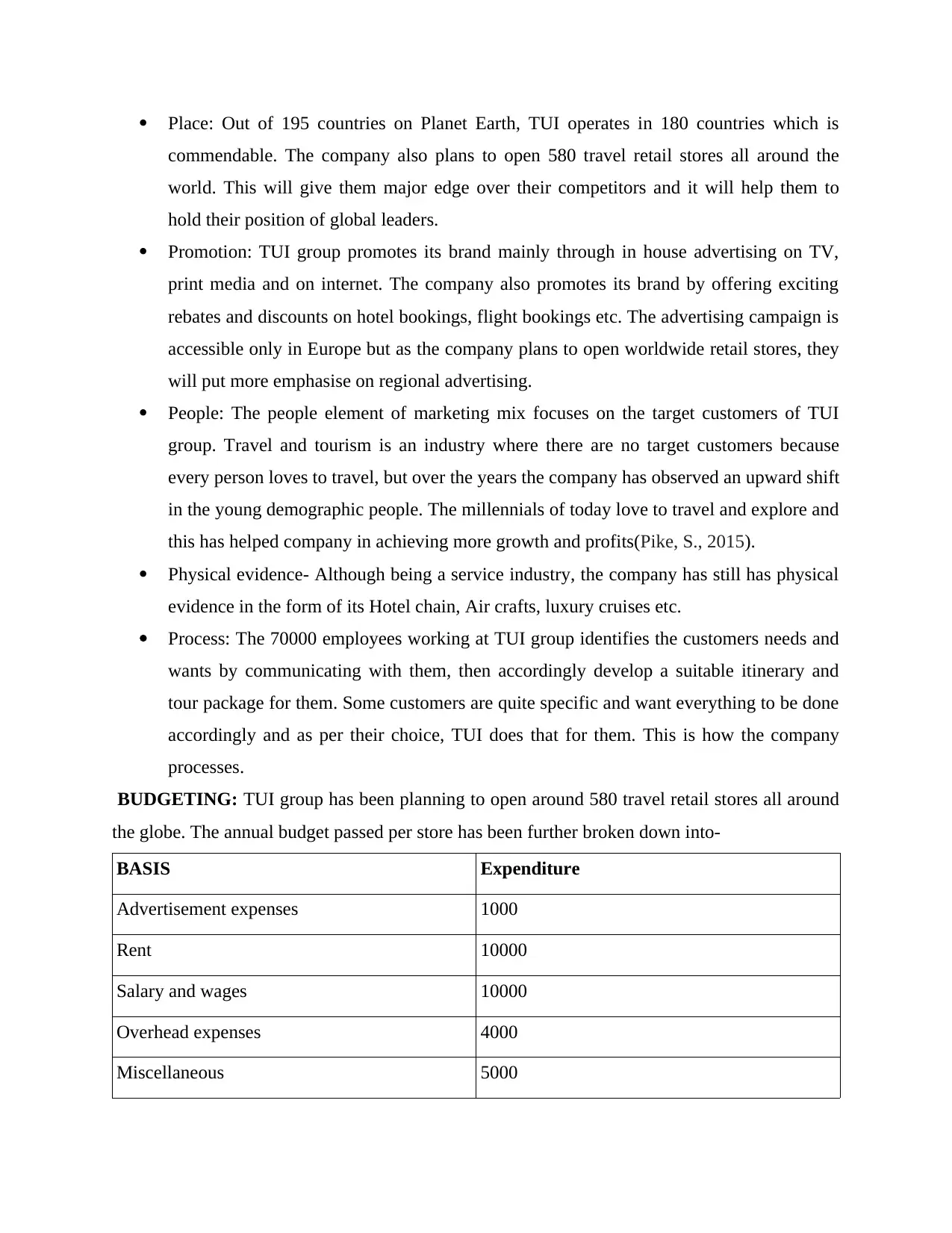
Place: Out of 195 countries on Planet Earth, TUI operates in 180 countries which is
commendable. The company also plans to open 580 travel retail stores all around the
world. This will give them major edge over their competitors and it will help them to
hold their position of global leaders.
Promotion: TUI group promotes its brand mainly through in house advertising on TV,
print media and on internet. The company also promotes its brand by offering exciting
rebates and discounts on hotel bookings, flight bookings etc. The advertising campaign is
accessible only in Europe but as the company plans to open worldwide retail stores, they
will put more emphasise on regional advertising.
People: The people element of marketing mix focuses on the target customers of TUI
group. Travel and tourism is an industry where there are no target customers because
every person loves to travel, but over the years the company has observed an upward shift
in the young demographic people. The millennials of today love to travel and explore and
this has helped company in achieving more growth and profits(Pike, S., 2015).
Physical evidence- Although being a service industry, the company has still has physical
evidence in the form of its Hotel chain, Air crafts, luxury cruises etc.
Process: The 70000 employees working at TUI group identifies the customers needs and
wants by communicating with them, then accordingly develop a suitable itinerary and
tour package for them. Some customers are quite specific and want everything to be done
accordingly and as per their choice, TUI does that for them. This is how the company
processes.
BUDGETING: TUI group has been planning to open around 580 travel retail stores all around
the globe. The annual budget passed per store has been further broken down into-
BASIS Expenditure
Advertisement expenses 1000
Rent 10000
Salary and wages 10000
Overhead expenses 4000
Miscellaneous 5000
commendable. The company also plans to open 580 travel retail stores all around the
world. This will give them major edge over their competitors and it will help them to
hold their position of global leaders.
Promotion: TUI group promotes its brand mainly through in house advertising on TV,
print media and on internet. The company also promotes its brand by offering exciting
rebates and discounts on hotel bookings, flight bookings etc. The advertising campaign is
accessible only in Europe but as the company plans to open worldwide retail stores, they
will put more emphasise on regional advertising.
People: The people element of marketing mix focuses on the target customers of TUI
group. Travel and tourism is an industry where there are no target customers because
every person loves to travel, but over the years the company has observed an upward shift
in the young demographic people. The millennials of today love to travel and explore and
this has helped company in achieving more growth and profits(Pike, S., 2015).
Physical evidence- Although being a service industry, the company has still has physical
evidence in the form of its Hotel chain, Air crafts, luxury cruises etc.
Process: The 70000 employees working at TUI group identifies the customers needs and
wants by communicating with them, then accordingly develop a suitable itinerary and
tour package for them. Some customers are quite specific and want everything to be done
accordingly and as per their choice, TUI does that for them. This is how the company
processes.
BUDGETING: TUI group has been planning to open around 580 travel retail stores all around
the globe. The annual budget passed per store has been further broken down into-
BASIS Expenditure
Advertisement expenses 1000
Rent 10000
Salary and wages 10000
Overhead expenses 4000
Miscellaneous 5000
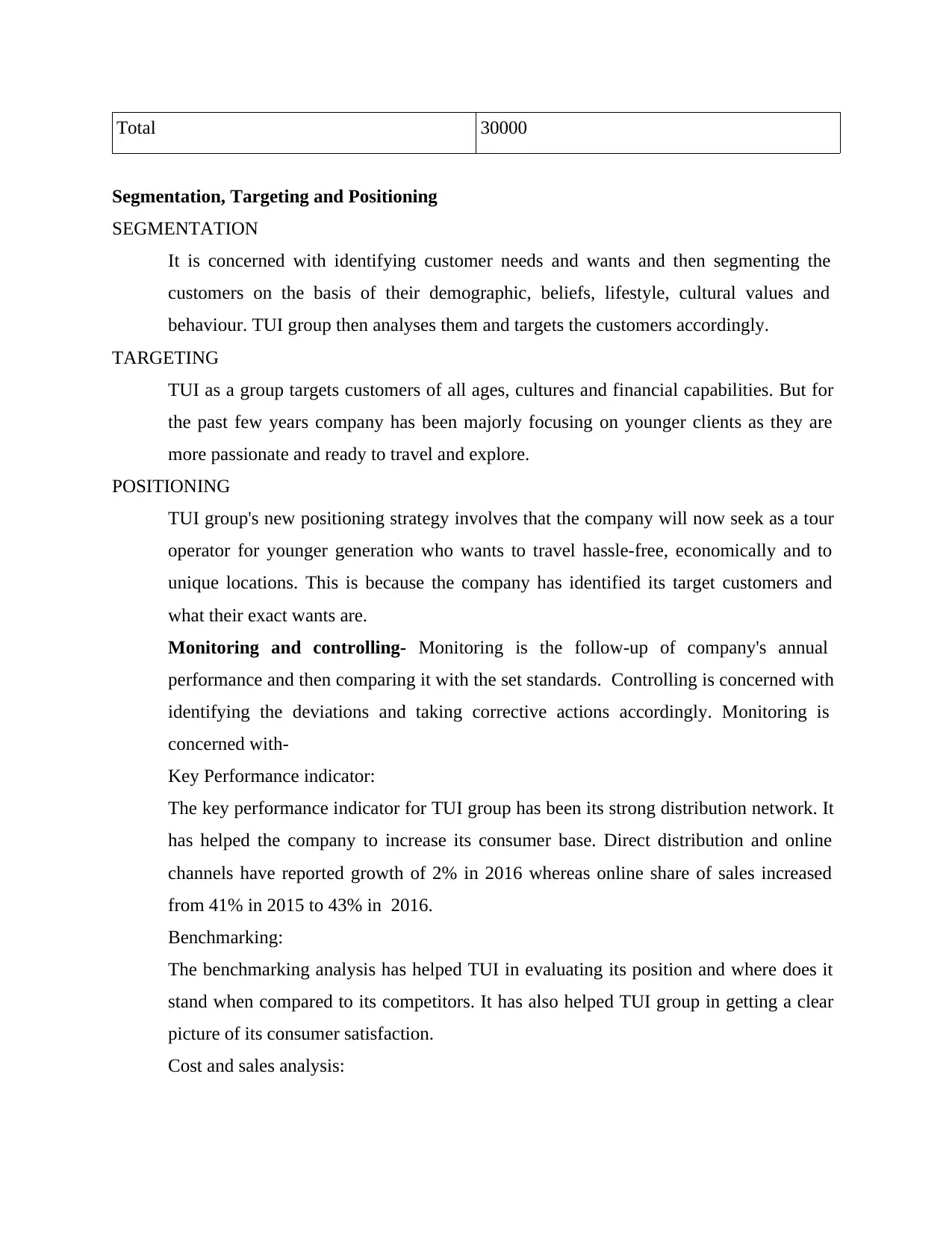
Total 30000
Segmentation, Targeting and Positioning
SEGMENTATION
It is concerned with identifying customer needs and wants and then segmenting the
customers on the basis of their demographic, beliefs, lifestyle, cultural values and
behaviour. TUI group then analyses them and targets the customers accordingly.
TARGETING
TUI as a group targets customers of all ages, cultures and financial capabilities. But for
the past few years company has been majorly focusing on younger clients as they are
more passionate and ready to travel and explore.
POSITIONING
TUI group's new positioning strategy involves that the company will now seek as a tour
operator for younger generation who wants to travel hassle-free, economically and to
unique locations. This is because the company has identified its target customers and
what their exact wants are.
Monitoring and controlling- Monitoring is the follow-up of company's annual
performance and then comparing it with the set standards. Controlling is concerned with
identifying the deviations and taking corrective actions accordingly. Monitoring is
concerned with-
Key Performance indicator:
The key performance indicator for TUI group has been its strong distribution network. It
has helped the company to increase its consumer base. Direct distribution and online
channels have reported growth of 2% in 2016 whereas online share of sales increased
from 41% in 2015 to 43% in 2016.
Benchmarking:
The benchmarking analysis has helped TUI in evaluating its position and where does it
stand when compared to its competitors. It has also helped TUI group in getting a clear
picture of its consumer satisfaction.
Cost and sales analysis:
Segmentation, Targeting and Positioning
SEGMENTATION
It is concerned with identifying customer needs and wants and then segmenting the
customers on the basis of their demographic, beliefs, lifestyle, cultural values and
behaviour. TUI group then analyses them and targets the customers accordingly.
TARGETING
TUI as a group targets customers of all ages, cultures and financial capabilities. But for
the past few years company has been majorly focusing on younger clients as they are
more passionate and ready to travel and explore.
POSITIONING
TUI group's new positioning strategy involves that the company will now seek as a tour
operator for younger generation who wants to travel hassle-free, economically and to
unique locations. This is because the company has identified its target customers and
what their exact wants are.
Monitoring and controlling- Monitoring is the follow-up of company's annual
performance and then comparing it with the set standards. Controlling is concerned with
identifying the deviations and taking corrective actions accordingly. Monitoring is
concerned with-
Key Performance indicator:
The key performance indicator for TUI group has been its strong distribution network. It
has helped the company to increase its consumer base. Direct distribution and online
channels have reported growth of 2% in 2016 whereas online share of sales increased
from 41% in 2015 to 43% in 2016.
Benchmarking:
The benchmarking analysis has helped TUI in evaluating its position and where does it
stand when compared to its competitors. It has also helped TUI group in getting a clear
picture of its consumer satisfaction.
Cost and sales analysis:
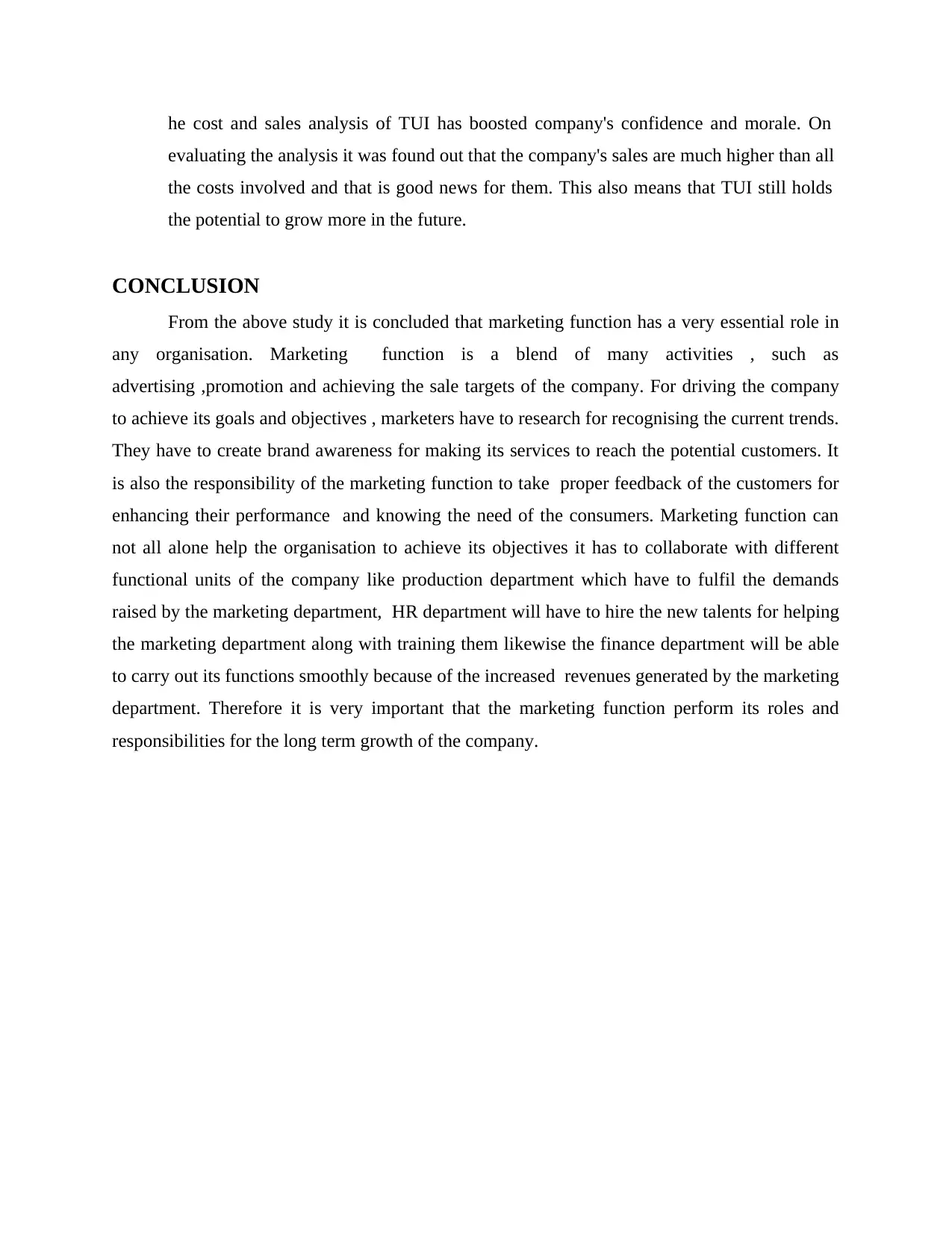
he cost and sales analysis of TUI has boosted company's confidence and morale. On
evaluating the analysis it was found out that the company's sales are much higher than all
the costs involved and that is good news for them. This also means that TUI still holds
the potential to grow more in the future.
CONCLUSION
From the above study it is concluded that marketing function has a very essential role in
any organisation. Marketing function is a blend of many activities , such as
advertising ,promotion and achieving the sale targets of the company. For driving the company
to achieve its goals and objectives , marketers have to research for recognising the current trends.
They have to create brand awareness for making its services to reach the potential customers. It
is also the responsibility of the marketing function to take proper feedback of the customers for
enhancing their performance and knowing the need of the consumers. Marketing function can
not all alone help the organisation to achieve its objectives it has to collaborate with different
functional units of the company like production department which have to fulfil the demands
raised by the marketing department, HR department will have to hire the new talents for helping
the marketing department along with training them likewise the finance department will be able
to carry out its functions smoothly because of the increased revenues generated by the marketing
department. Therefore it is very important that the marketing function perform its roles and
responsibilities for the long term growth of the company.
evaluating the analysis it was found out that the company's sales are much higher than all
the costs involved and that is good news for them. This also means that TUI still holds
the potential to grow more in the future.
CONCLUSION
From the above study it is concluded that marketing function has a very essential role in
any organisation. Marketing function is a blend of many activities , such as
advertising ,promotion and achieving the sale targets of the company. For driving the company
to achieve its goals and objectives , marketers have to research for recognising the current trends.
They have to create brand awareness for making its services to reach the potential customers. It
is also the responsibility of the marketing function to take proper feedback of the customers for
enhancing their performance and knowing the need of the consumers. Marketing function can
not all alone help the organisation to achieve its objectives it has to collaborate with different
functional units of the company like production department which have to fulfil the demands
raised by the marketing department, HR department will have to hire the new talents for helping
the marketing department along with training them likewise the finance department will be able
to carry out its functions smoothly because of the increased revenues generated by the marketing
department. Therefore it is very important that the marketing function perform its roles and
responsibilities for the long term growth of the company.
Paraphrase This Document
Need a fresh take? Get an instant paraphrase of this document with our AI Paraphraser
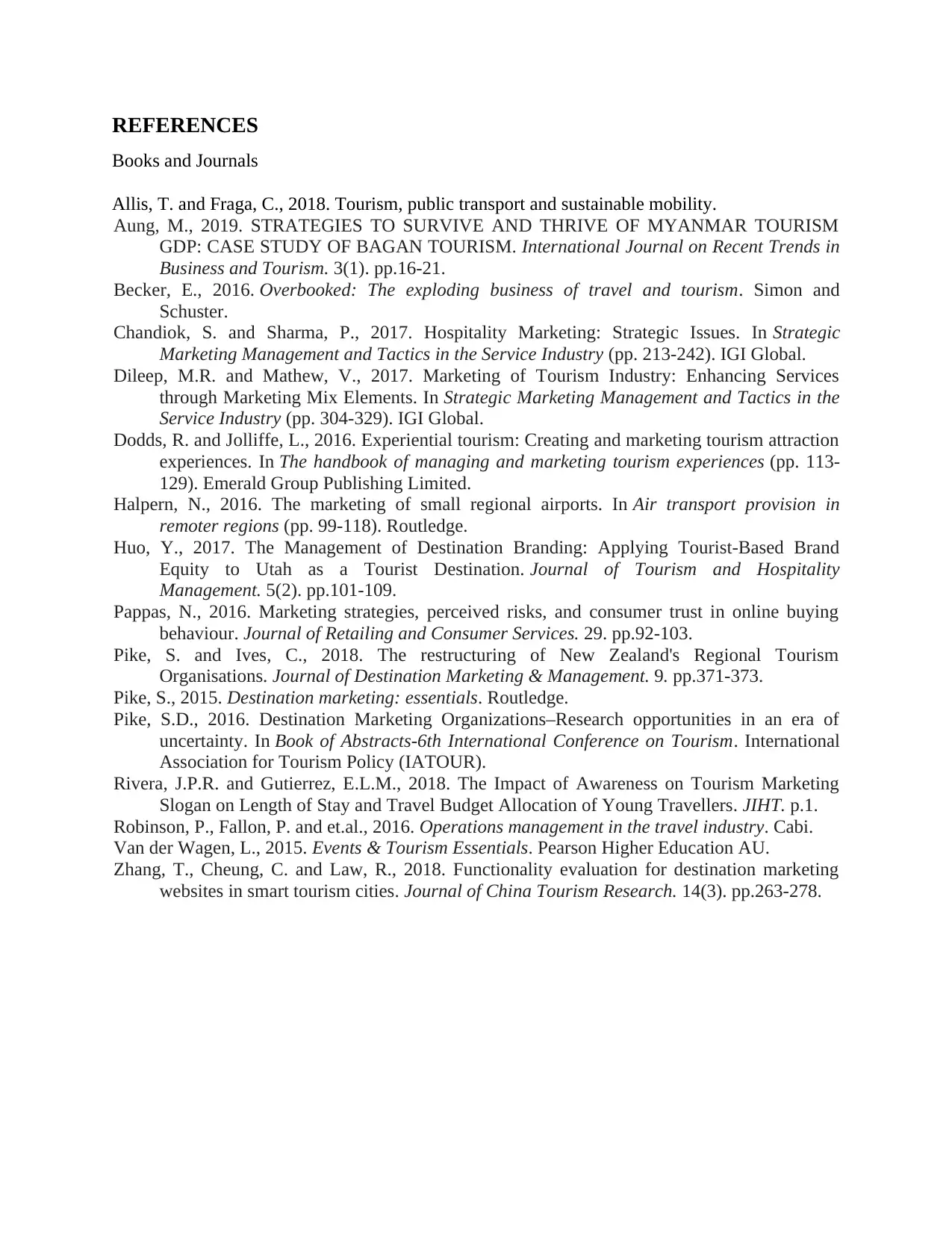
REFERENCES
Books and Journals
Allis, T. and Fraga, C., 2018. Tourism, public transport and sustainable mobility.
Aung, M., 2019. STRATEGIES TO SURVIVE AND THRIVE OF MYANMAR TOURISM
GDP: CASE STUDY OF BAGAN TOURISM. International Journal on Recent Trends in
Business and Tourism. 3(1). pp.16-21.
Becker, E., 2016. Overbooked: The exploding business of travel and tourism. Simon and
Schuster.
Chandiok, S. and Sharma, P., 2017. Hospitality Marketing: Strategic Issues. In Strategic
Marketing Management and Tactics in the Service Industry (pp. 213-242). IGI Global.
Dileep, M.R. and Mathew, V., 2017. Marketing of Tourism Industry: Enhancing Services
through Marketing Mix Elements. In Strategic Marketing Management and Tactics in the
Service Industry (pp. 304-329). IGI Global.
Dodds, R. and Jolliffe, L., 2016. Experiential tourism: Creating and marketing tourism attraction
experiences. In The handbook of managing and marketing tourism experiences (pp. 113-
129). Emerald Group Publishing Limited.
Halpern, N., 2016. The marketing of small regional airports. In Air transport provision in
remoter regions (pp. 99-118). Routledge.
Huo, Y., 2017. The Management of Destination Branding: Applying Tourist-Based Brand
Equity to Utah as a Tourist Destination. Journal of Tourism and Hospitality
Management. 5(2). pp.101-109.
Pappas, N., 2016. Marketing strategies, perceived risks, and consumer trust in online buying
behaviour. Journal of Retailing and Consumer Services. 29. pp.92-103.
Pike, S. and Ives, C., 2018. The restructuring of New Zealand's Regional Tourism
Organisations. Journal of Destination Marketing & Management. 9. pp.371-373.
Pike, S., 2015. Destination marketing: essentials. Routledge.
Pike, S.D., 2016. Destination Marketing Organizations–Research opportunities in an era of
uncertainty. In Book of Abstracts-6th International Conference on Tourism. International
Association for Tourism Policy (IATOUR).
Rivera, J.P.R. and Gutierrez, E.L.M., 2018. The Impact of Awareness on Tourism Marketing
Slogan on Length of Stay and Travel Budget Allocation of Young Travellers. JIHT. p.1.
Robinson, P., Fallon, P. and et.al., 2016. Operations management in the travel industry. Cabi.
Van der Wagen, L., 2015. Events & Tourism Essentials. Pearson Higher Education AU.
Zhang, T., Cheung, C. and Law, R., 2018. Functionality evaluation for destination marketing
websites in smart tourism cities. Journal of China Tourism Research. 14(3). pp.263-278.
Books and Journals
Allis, T. and Fraga, C., 2018. Tourism, public transport and sustainable mobility.
Aung, M., 2019. STRATEGIES TO SURVIVE AND THRIVE OF MYANMAR TOURISM
GDP: CASE STUDY OF BAGAN TOURISM. International Journal on Recent Trends in
Business and Tourism. 3(1). pp.16-21.
Becker, E., 2016. Overbooked: The exploding business of travel and tourism. Simon and
Schuster.
Chandiok, S. and Sharma, P., 2017. Hospitality Marketing: Strategic Issues. In Strategic
Marketing Management and Tactics in the Service Industry (pp. 213-242). IGI Global.
Dileep, M.R. and Mathew, V., 2017. Marketing of Tourism Industry: Enhancing Services
through Marketing Mix Elements. In Strategic Marketing Management and Tactics in the
Service Industry (pp. 304-329). IGI Global.
Dodds, R. and Jolliffe, L., 2016. Experiential tourism: Creating and marketing tourism attraction
experiences. In The handbook of managing and marketing tourism experiences (pp. 113-
129). Emerald Group Publishing Limited.
Halpern, N., 2016. The marketing of small regional airports. In Air transport provision in
remoter regions (pp. 99-118). Routledge.
Huo, Y., 2017. The Management of Destination Branding: Applying Tourist-Based Brand
Equity to Utah as a Tourist Destination. Journal of Tourism and Hospitality
Management. 5(2). pp.101-109.
Pappas, N., 2016. Marketing strategies, perceived risks, and consumer trust in online buying
behaviour. Journal of Retailing and Consumer Services. 29. pp.92-103.
Pike, S. and Ives, C., 2018. The restructuring of New Zealand's Regional Tourism
Organisations. Journal of Destination Marketing & Management. 9. pp.371-373.
Pike, S., 2015. Destination marketing: essentials. Routledge.
Pike, S.D., 2016. Destination Marketing Organizations–Research opportunities in an era of
uncertainty. In Book of Abstracts-6th International Conference on Tourism. International
Association for Tourism Policy (IATOUR).
Rivera, J.P.R. and Gutierrez, E.L.M., 2018. The Impact of Awareness on Tourism Marketing
Slogan on Length of Stay and Travel Budget Allocation of Young Travellers. JIHT. p.1.
Robinson, P., Fallon, P. and et.al., 2016. Operations management in the travel industry. Cabi.
Van der Wagen, L., 2015. Events & Tourism Essentials. Pearson Higher Education AU.
Zhang, T., Cheung, C. and Law, R., 2018. Functionality evaluation for destination marketing
websites in smart tourism cities. Journal of China Tourism Research. 14(3). pp.263-278.
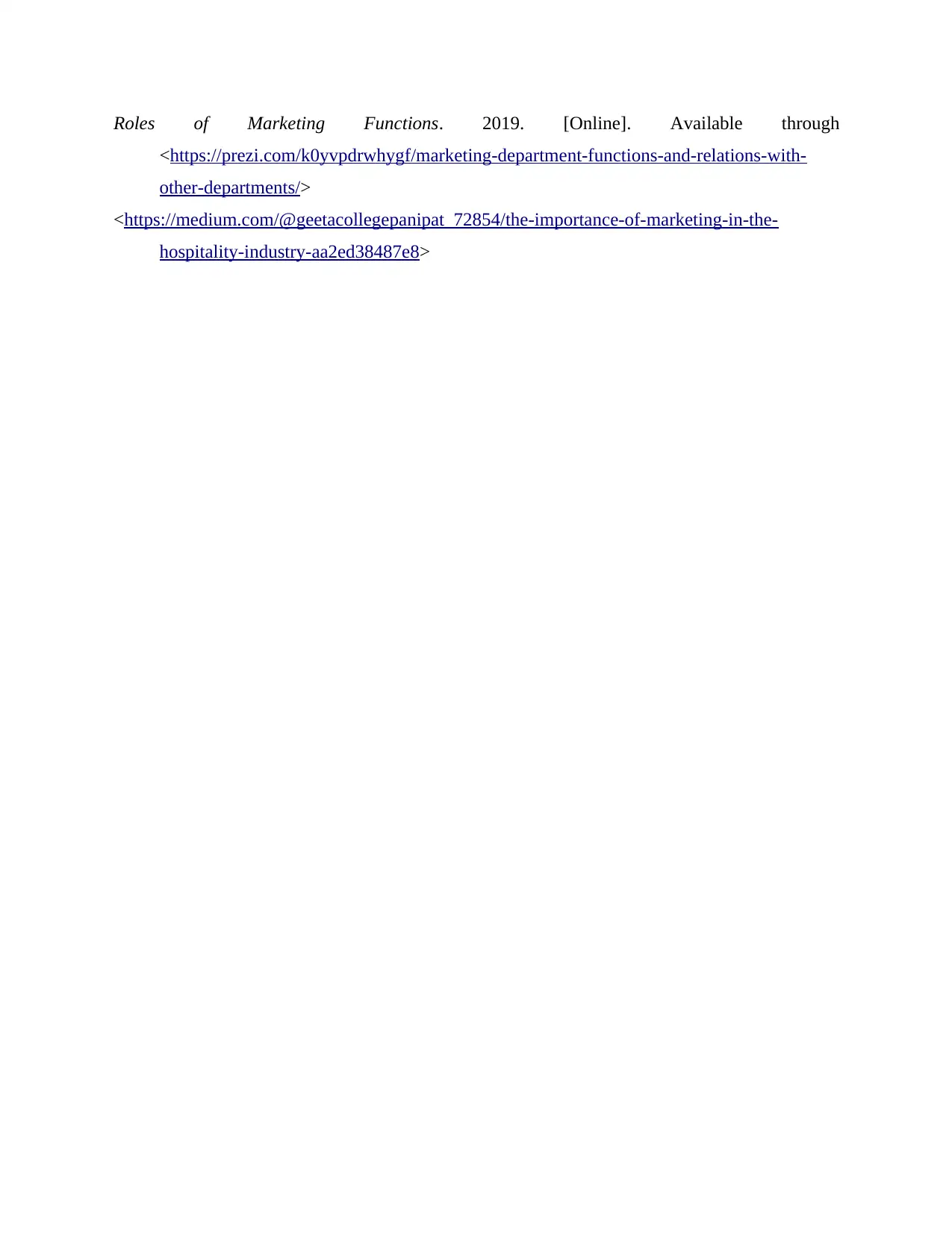
Roles of Marketing Functions. 2019. [Online]. Available through
<https://prezi.com/k0yvpdrwhygf/marketing-department-functions-and-relations-with-
other-departments/>
<https://medium.com/@geetacollegepanipat_72854/the-importance-of-marketing-in-the-
hospitality-industry-aa2ed38487e8>
<https://prezi.com/k0yvpdrwhygf/marketing-department-functions-and-relations-with-
other-departments/>
<https://medium.com/@geetacollegepanipat_72854/the-importance-of-marketing-in-the-
hospitality-industry-aa2ed38487e8>

Secure Best Marks with AI Grader
Need help grading? Try our AI Grader for instant feedback on your assignments.

1
1 out of 17
Related Documents
Your All-in-One AI-Powered Toolkit for Academic Success.
+13062052269
info@desklib.com
Available 24*7 on WhatsApp / Email
![[object Object]](/_next/static/media/star-bottom.7253800d.svg)
Unlock your academic potential
© 2024 | Zucol Services PVT LTD | All rights reserved.





